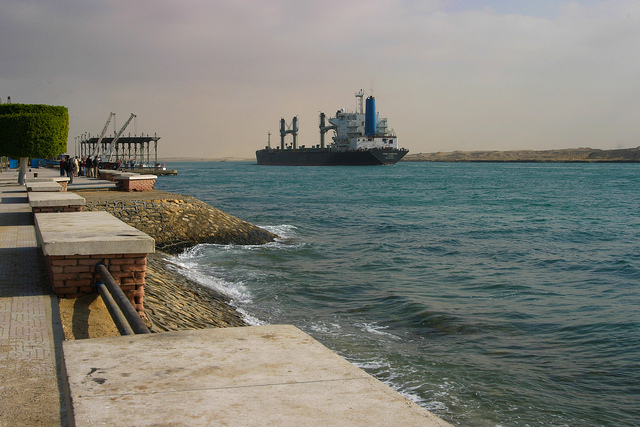The Suez Canal is an artificial waterway in Egypt that connects the Mediterranean to the Red Sea through the Isthmus of Suez. The waterway separates Asia and Africa and provides the shortest possible maritime route between the North Atlantic and the northern Indian Ocean, reducing the trip for more than 4,000 miles by avoiding the long and dangerous southern route.
The canal is one of the most important waterways in the world and one of the most heavily used shipping lanes. It is operated and owned by the Suez Canal Authority and under the Convention of Constantinople it may be used “in time of war as in time of peace, by every vessel of commerce or of war, without distinction of flag.”
History

The Canal of Suez was officially opened on November 17th of 1869 after 10 years of arduous construction. However, the history of the canal dates back to ancient Egypt and the pharaohs back in the 13th century B.C.E. Smaller canals were built back then in order to connect the Nile with the Red Sea. It is said that both the Pharaoh Necho II and the Persian conqueror Darius abandoned attempts to build a canal of similar proportions during their time. The Canal of the Pharaohs, Ancient Suez Canal or Necho’s Canal are the names give to this rudimentary precursor of what the Suez Canal is today.
From the beginning, many tried to build this waterway but had to stop as they faced challenges like the water level different and also the problem mixing salt water from the ocean with that of the Nile. Around 274 BC, Ptolemy II’s engineers were able to find a way to stop salt water from mixing with that of the Nile by using water locks. Water locks are used to hold water in certain areas thus making it possible to navigate between two bodies of water at different levels.
Napoleon Bonaparte was also somewhat involved in the history of the Canal. After conquering Egypt in 1798, Bonaparte had several of his best archaeologists, scientists, cartographers and engineers looked for evidence of the location of this ancient canal, in an attempt to build the waterway that would connect the Mediterranean with the Red Sea. A mix of wrong information gathered by his people in regards of the height of the Red Sea compared to that of the Mediterranean; and the difficulty and expense posed by the need to construct water locks in order to make the structure work, made Napoleon abandon the endeavor.
The next attempt to build the canal came in the mid 1800s by the French engineer Ferdinand de Lesseps, who gained the support of Sa’id Pasha, the Khedive of Egypt and Sudan, to create a company to build the canal. The plan was for the Universal Suez Ship Canal Company to build the canal and operate it for 99 years to later give control up to the Egyptian government. Construction began in April of 1859, it lasted 10 years and the total cost was that of $100 million dollars.

Operation and Layout
At the time of its opening, the canal was 102 miles long and 26 feet in depth. After many adjustments, today it is 120.11 miles in length, 79 feet deep and 673 feet wide. It has a northern access channel that is 14 miles long, the canal itself of 100.82 miles and the southern access channel of 5.6 miles. The capacity was further adjusted and enhanced as of August of last year, when they project of the New Canal of Suez became functional. This project added a new 22-mile long shipping lane allowing for ships to be sailing in both directions for the vast majority of the entire length of the canal. The inability to have ships constantly moving in both directions made it so users had to wait about 11 hours for their turn to get across. With this new addition, the waiting time now is somewhere around 3 hours and the daily capacity to get ships across pretty much doubled.
A funny fact about the canal
When the canal was completed in 1869 French sculptor Frédéric-Auguste Bartholdi attempted to convince Ferdinand de Lesseps and the Egyptian government to let him put up a sculpture called “Egypt Bringing Light to Asia” at the Mediterranean entrance of the canal. The sculpture would depict a woman wearing peasant robes and holding a torch that would serve as a guiding light to ships coming in. Bartholdi continued to pitch his idea and eventually in 1886 it was unveiled at New York under the official name of “Liberty Enlightening the World”, but we all know her today as The Statue of Liberty.
Check out more of our articles for the latest on modern wonders of today at Kenny Slaught’s Blog.